This week members of the International Reading Association's Children's Literature and Reading Special Interest Group (CL/R SIG) share recent books all around the theme of math. Each title takes a different mathematical perspective from counting, adding, subtraction, graphing to multiplication. Building math skills through literature can create confidence and make learning fun. Literature could be used as a way to introduce new math concepts, review math theories and/or have students independently explore math ideas.
GRADES K-3
Armstrong-Ellis, Carey F. (2012). Ten creepy monsters. New York: Abrams Books for Young Readers.
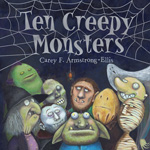 This fiendishly clever counting book features characters not typically found in books introducing math concepts—monsters. The endpapers are covered in spider webs with spiders dangling from the threads, and the book opens with an oceanside graveyard scene in which monsters are rising from their burial mounds. One of them clutches a bag filled with something. After all, it is Halloween night. Ten different monsters—a ghost, a witch, a zombie, a werewolf, and a vampire among them—gather together on the first pages of this book written in rhyming text, before setting out on their journey. But before they can wreak any havoc, one by one, bad things happen to them. By the end of the night, only one monster remains, and his identity will surprise some young readers. The acrylic illustrations showing the expressions on the monsters' faces as they lurch toward town add another layer of hilarity to the story. The illustration of a zombie clutching the foot he lost along the way and the artistic depiction of a swamp brew-splashed toad wearing a witch's hat and glasses are hilarious. A perfect Halloween read-aloud but a great way to relieve malaise on any day, this picture book also helps young readers learn to count as the monsters fall by the wayside in gruesome fashion.
This fiendishly clever counting book features characters not typically found in books introducing math concepts—monsters. The endpapers are covered in spider webs with spiders dangling from the threads, and the book opens with an oceanside graveyard scene in which monsters are rising from their burial mounds. One of them clutches a bag filled with something. After all, it is Halloween night. Ten different monsters—a ghost, a witch, a zombie, a werewolf, and a vampire among them—gather together on the first pages of this book written in rhyming text, before setting out on their journey. But before they can wreak any havoc, one by one, bad things happen to them. By the end of the night, only one monster remains, and his identity will surprise some young readers. The acrylic illustrations showing the expressions on the monsters' faces as they lurch toward town add another layer of hilarity to the story. The illustration of a zombie clutching the foot he lost along the way and the artistic depiction of a swamp brew-splashed toad wearing a witch's hat and glasses are hilarious. A perfect Halloween read-aloud but a great way to relieve malaise on any day, this picture book also helps young readers learn to count as the monsters fall by the wayside in gruesome fashion.
- Barbara A. Ward, Washington State University Pullman
Brown, Margaret Wise. (2012). Count to 10 with a mouse. Illus. by Kirsten Richards. Bath, UK: Parragon.
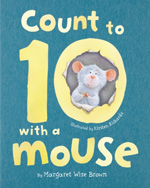 From the author of Good Night Moon (2005) and Runway Bunny (2005) comes another engaging book that is filled with adventure, rhyme, and fun. Children may even forget that they are learning to count while reading this title. The book opens with the rhyme, “There was a little mouse no bigger than a mole, who lived in a round place that he called a hole” (unpaged). This particular small grey mouse is very friendly and familiar, inviting readers to turn the page to see what happens. The mouse does everything with style. He finds a book with one hole, and then runs inside the hole in order to see the different creatures on the pages. His adventures become exciting when he discovers fish, monkeys, butterflies and other creatures, but they take a dangerous turn when he meets six pussycats. Thankfully, they are busy untangling themselves, and the mouse escapes. Phew! After the mouse encounters a clock, the author reminds readers of the nursery rhyme, “Hickory, Dickory, Dock,” before nimbly moving the story back to its original focus. Readers will enjoy finding out what happens when the mouse reaches the number ten. Perfect for reading aloud, this title provides a place to begin conversations about numbers. The book would also be useful as a mentor text to teach writing to older students.
From the author of Good Night Moon (2005) and Runway Bunny (2005) comes another engaging book that is filled with adventure, rhyme, and fun. Children may even forget that they are learning to count while reading this title. The book opens with the rhyme, “There was a little mouse no bigger than a mole, who lived in a round place that he called a hole” (unpaged). This particular small grey mouse is very friendly and familiar, inviting readers to turn the page to see what happens. The mouse does everything with style. He finds a book with one hole, and then runs inside the hole in order to see the different creatures on the pages. His adventures become exciting when he discovers fish, monkeys, butterflies and other creatures, but they take a dangerous turn when he meets six pussycats. Thankfully, they are busy untangling themselves, and the mouse escapes. Phew! After the mouse encounters a clock, the author reminds readers of the nursery rhyme, “Hickory, Dickory, Dock,” before nimbly moving the story back to its original focus. Readers will enjoy finding out what happens when the mouse reaches the number ten. Perfect for reading aloud, this title provides a place to begin conversations about numbers. The book would also be useful as a mentor text to teach writing to older students.
- Rani Iyer, Washington State University, Pullman
Formento, Alison. (2012). These bees count! Illus. by Sarah Snow. New York: Albert Whitman.
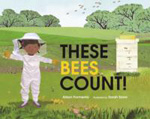 This is a counting book and so much more. Mr. Tate takes his class on a field trip to visit Busy Bee Farm. Farmer Ellen is ready to give his class a tour of the farm and gives each student beekeeping gear so they are safely protected to take a close look at the bees and all the activity surrounding the hives. As the children approach the bees and hives the counting begins. The author has included a detailed note at the end providing even more information about the lives of bees and the work they do. Detailed teacher’s guide, book trailer and resources at the publisher’s website.
This is a counting book and so much more. Mr. Tate takes his class on a field trip to visit Busy Bee Farm. Farmer Ellen is ready to give his class a tour of the farm and gives each student beekeeping gear so they are safely protected to take a close look at the bees and all the activity surrounding the hives. As the children approach the bees and hives the counting begins. The author has included a detailed note at the end providing even more information about the lives of bees and the work they do. Detailed teacher’s guide, book trailer and resources at the publisher’s website.
- Karen Hildebrand, Ohio Library and Reading Consultant
Gershator, Phillis and Mim Green. (2012). Time for a hug. Illus. by David Walker. New York: Sterling Children’s Books.
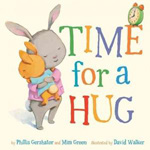 Any time is time for a hug. Watching the clock throughout the day, two little bunnies go through a typical day for any young child. Starting at 8:00 in the morning the bunnies wash their faces, get dressed, brush their teeth, play with puppets, read books, ride bikes, climb trees until it is time for bed. With clocks on every page indicating the passing hours, each hour has time for a hug. Be ready for National Hug Day on January 21. Also visit the author’s website or use the “Draw a Math Story” lesson from ReadWriteThink.
Any time is time for a hug. Watching the clock throughout the day, two little bunnies go through a typical day for any young child. Starting at 8:00 in the morning the bunnies wash their faces, get dressed, brush their teeth, play with puppets, read books, ride bikes, climb trees until it is time for bed. With clocks on every page indicating the passing hours, each hour has time for a hug. Be ready for National Hug Day on January 21. Also visit the author’s website or use the “Draw a Math Story” lesson from ReadWriteThink.
- Karen Hildebrand, Ohio Library and Reading Consultant
Holub, Joan. (2012). Pumpkin countdown. Illus. by Jan Smith. New York: Albert Whitman.
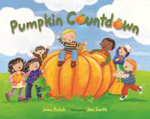 Farmer Mixenmatch is giving a tour of his farm and especially the pumpkin patch to Ms. Blue’s first grade class. He shows the children his petting zoo, gives them a ride on the tractor, shows them the corn make and also the education center at the farm. Holub has used rhyming verse to travel around the farm and have readers count things on each page that they discover on the farm. Answers are upside down at the bottom of the page. Her countdown actually starts and 20 and works the numbers down as children explore the farm and readers explore for answers. The endpapers of the book have many more facts about pumpkins. This will be a fun book to use before any fall field trips. Teachers will find a math related lesson plan idea entitled “Exploring Sets through Math-Related Book Pairs” at ReadWriteThink.
Farmer Mixenmatch is giving a tour of his farm and especially the pumpkin patch to Ms. Blue’s first grade class. He shows the children his petting zoo, gives them a ride on the tractor, shows them the corn make and also the education center at the farm. Holub has used rhyming verse to travel around the farm and have readers count things on each page that they discover on the farm. Answers are upside down at the bottom of the page. Her countdown actually starts and 20 and works the numbers down as children explore the farm and readers explore for answers. The endpapers of the book have many more facts about pumpkins. This will be a fun book to use before any fall field trips. Teachers will find a math related lesson plan idea entitled “Exploring Sets through Math-Related Book Pairs” at ReadWriteThink.
- Karen Hildebrand, Ohio Library and Reading Consultant
Holub, Joan. (2012). Zero the hero: A book about nothing. Illus. by Tom Lichtenheld. New York: Henry Holt and Company.
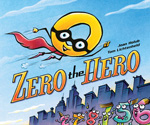 Although this is a book literally about nothing, it’s a book dealing with a very important mathematical concept. The book’s focus is Zero, the place holder in our numbering system. But despite the other numbers’ disparaging remarks about his value, Zero is much more than a place holder, and this book tells why. Although Zero is sure he has value, the other numbers taunt him because he is useless when it comes to counting. Knowing that he has heroic characteristics, Zero develops a self-identity crisis since he only acquires value when placed next to another number, say a “1,” to make a “10.” He’s also frequently mistaken for other round objects such as the “6” or even a doughnut or the letter “O” and is useless when it comes to addition, subtraction, and division. Once the other numbers recognize that multiplying themselves by Zero makes them equal to nothing, they flee from him, and in shame, Zero rolls away and hides. After some challenging story problems and a round-off game make them miss their friend, the numbers become distracted and are captured by Roman numerals. Zero saves them with his ability to reduce anything to nothing through multiplication. As in last year’s E-Mergency!, the book brims with delightful word play and ink, pastel, and colored pencil illustrations that provide distinct personalities for each numeral. Math never has been so much fun.
Although this is a book literally about nothing, it’s a book dealing with a very important mathematical concept. The book’s focus is Zero, the place holder in our numbering system. But despite the other numbers’ disparaging remarks about his value, Zero is much more than a place holder, and this book tells why. Although Zero is sure he has value, the other numbers taunt him because he is useless when it comes to counting. Knowing that he has heroic characteristics, Zero develops a self-identity crisis since he only acquires value when placed next to another number, say a “1,” to make a “10.” He’s also frequently mistaken for other round objects such as the “6” or even a doughnut or the letter “O” and is useless when it comes to addition, subtraction, and division. Once the other numbers recognize that multiplying themselves by Zero makes them equal to nothing, they flee from him, and in shame, Zero rolls away and hides. After some challenging story problems and a round-off game make them miss their friend, the numbers become distracted and are captured by Roman numerals. Zero saves them with his ability to reduce anything to nothing through multiplication. As in last year’s E-Mergency!, the book brims with delightful word play and ink, pastel, and colored pencil illustrations that provide distinct personalities for each numeral. Math never has been so much fun.
- Barbara A. Ward, Washington State University, Pullman
Long, Ethan. (2012). The wing wing brothers math spectacular! New York: Holiday House.
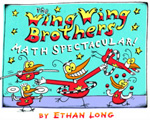 The Wing Wing Brothers, five hilarious duck brothers, present a circus-like show that has fun with math concepts. In three acts, the brothers try to outdo each other with their laugh-inducing tricks like spinning plates, juggling and throwing pies. Each acts presents a different math concept including greater than and less than, addition and subtraction while creating math problems within the reading circus acts. The final act includes a disappearance the readers will have to ponder and figure out the solution. This book offers such a fun approach to not only these math concepts the story problems to be solved. Teachers will appreciate the page at the end that relates Common Core State Standards to this book. “Writing and Math with Shopping Lists” can be found at ReadWriteThink. The author’s blog/website is filled with fun for young readers.
The Wing Wing Brothers, five hilarious duck brothers, present a circus-like show that has fun with math concepts. In three acts, the brothers try to outdo each other with their laugh-inducing tricks like spinning plates, juggling and throwing pies. Each acts presents a different math concept including greater than and less than, addition and subtraction while creating math problems within the reading circus acts. The final act includes a disappearance the readers will have to ponder and figure out the solution. This book offers such a fun approach to not only these math concepts the story problems to be solved. Teachers will appreciate the page at the end that relates Common Core State Standards to this book. “Writing and Math with Shopping Lists” can be found at ReadWriteThink. The author’s blog/website is filled with fun for young readers.
- Karen Hildebrand, Ohio Library and Reading Consultant
Marzollo, Jean. (2012). Help me learn subtraction. Photographs by Chad Phillips. New York: Holiday House.
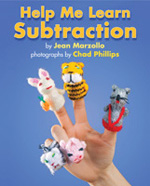 Marzollo’s popular “I Spy” books are favorites among children. She has turned that same style of book making to the math arena and this is the third book in the Help Me Learn Math series. Chad Phillips’ photographs add the actively visual appeal of this book and each math problem as a wide variety of real objects displayed to create the math problem written in rhymed text. For each subtraction problem the author has created the vertical and horizontal setup of the math problem and in some cases a basic little word problem presented as dramatic play. Explore some “Math Center Activities” at ReadWriteThink. The author discusses why she wrote this book on her website.
Marzollo’s popular “I Spy” books are favorites among children. She has turned that same style of book making to the math arena and this is the third book in the Help Me Learn Math series. Chad Phillips’ photographs add the actively visual appeal of this book and each math problem as a wide variety of real objects displayed to create the math problem written in rhymed text. For each subtraction problem the author has created the vertical and horizontal setup of the math problem and in some cases a basic little word problem presented as dramatic play. Explore some “Math Center Activities” at ReadWriteThink. The author discusses why she wrote this book on her website.
- Karen Hildebrand, Ohio Library and Reading Consultant
Menotti, Andrea. (2012). How many jelly beans? A giant book of giant numbers. Illus. by Yancey Labat. San Francisco, CA: Chronicle Books.
 Learning about big numbers should be portrayed in a big book and the oversize format of How Many Jelly Beans does just that. Aidan and Emma are offered some jellybean and so Emma says she will take 10. Aidan quickly comes back with his response that he wants 20 … and the jellybean battle begins. Each child asks for more and more jumping their requests by hundreds and thousands until they are realizing really big numbers! Emma challenges Aiden with the questions, “You can’t eat five hundred jelly beans.” This prompts the concept of dividing into so many per day and how many over a year’s span. The exaggerated fun spins off ending the book with a huge fold out page depicting a million jellybeans. This will be a great companion book to use with “Lucky Beans” by Becky Birtha to give this introduction to counting jellybeans a context. Teacher resources for this book are available at the publisher’s website. ReadWriteThink offers the lesson plan, “Giant Story Problems: Reading Comprehension through Math Problems.”
Learning about big numbers should be portrayed in a big book and the oversize format of How Many Jelly Beans does just that. Aidan and Emma are offered some jellybean and so Emma says she will take 10. Aidan quickly comes back with his response that he wants 20 … and the jellybean battle begins. Each child asks for more and more jumping their requests by hundreds and thousands until they are realizing really big numbers! Emma challenges Aiden with the questions, “You can’t eat five hundred jelly beans.” This prompts the concept of dividing into so many per day and how many over a year’s span. The exaggerated fun spins off ending the book with a huge fold out page depicting a million jellybeans. This will be a great companion book to use with “Lucky Beans” by Becky Birtha to give this introduction to counting jellybeans a context. Teacher resources for this book are available at the publisher’s website. ReadWriteThink offers the lesson plan, “Giant Story Problems: Reading Comprehension through Math Problems.”
- Karen Hildebrand, Ohio Library and Reading Consultant
Weill, Cynthia. (2012). Count me in: A parade of Mexican folk art numbers in English and Spanish. Figures by Guillermina, Josefina, Concepción and Irene Aguilar. El Paso, TX: Cinco Puntos Press.
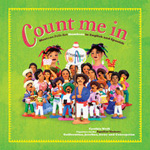 Told in English and Spanish, this beautiful counting book celebrates the Mexican July festival, Guelaguetza. The Aguilar sisters have used their craft to illustrated this book in the traditional folk arts of Oaxaca, Mexico. Balloons, firecrackers, musicians, and giants are all part of the festivities depicted in the figurines crafted to bring this festival of sharing to the printed page for both English and Spanish readers. Learn more about the world famous women artists, The Aguilar sisters. For a little deeper look into Mexican folk art, visit the Deep Space Sparkle website or another lesson idea comes from the Brooklyn Children’s Museum.
Told in English and Spanish, this beautiful counting book celebrates the Mexican July festival, Guelaguetza. The Aguilar sisters have used their craft to illustrated this book in the traditional folk arts of Oaxaca, Mexico. Balloons, firecrackers, musicians, and giants are all part of the festivities depicted in the figurines crafted to bring this festival of sharing to the printed page for both English and Spanish readers. Learn more about the world famous women artists, The Aguilar sisters. For a little deeper look into Mexican folk art, visit the Deep Space Sparkle website or another lesson idea comes from the Brooklyn Children’s Museum.
- Karen Hildebrand, Ohio Library and Reading Consultant
Zullo, Germano. (2012). Sky high. Illus. by Albertine. San Francisco, CA: Chronicle Books.
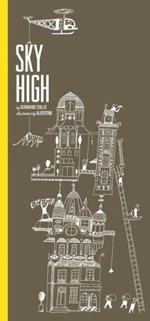 Keeping up with the Joneses is taken to extreme heights in this clever book about greed and proportion. With very little text, this title tells the story of two competitive neighbors who embellish their already attractive abodes in an attempt to outdo each other. The respective two-story houses of Agenor-Agobar Poirier des Chapelles and Willigis Kittycly Junior are impressive enough on the book’s opening pages. But what they have is not enough, and page by page, they add embellishments to their dwelling places. One adds a solid gold door, and the other counters with a Carrara marble column inlaid with diamonds. After that, the competition is on, and each one hires highly-priced architects who create mosaics fashioned from emeralds, rubies, and sapphires, design billiard rooms and rooms that can accommodate 8,000 guests, even attaching an antiques gallery, a wave pool, and a tennis court. Glimpses of what’s being brought into the inside of the houses—a stuffed Bengal tiger and a library of rare books, for instance—reveals even more of their excess to readers. Eventually, enough is enough, and once both buildings tower into the air at 4,025 feet—a line on the side of the right-hand page indicates this height—one structure topples since it can’t support all the rooms at its top. Although the other building still towers into the sky, its owner isn’t necessarily the victor since even the simple act of having a pizza delivered ends up being impossibly complicated. Readers will shake their heads at the two men’s greed and consider this an adult game of Jenga, the tumbling block game. The very black and white illustrations are exquisitely detailed and fascinating to examine.
Keeping up with the Joneses is taken to extreme heights in this clever book about greed and proportion. With very little text, this title tells the story of two competitive neighbors who embellish their already attractive abodes in an attempt to outdo each other. The respective two-story houses of Agenor-Agobar Poirier des Chapelles and Willigis Kittycly Junior are impressive enough on the book’s opening pages. But what they have is not enough, and page by page, they add embellishments to their dwelling places. One adds a solid gold door, and the other counters with a Carrara marble column inlaid with diamonds. After that, the competition is on, and each one hires highly-priced architects who create mosaics fashioned from emeralds, rubies, and sapphires, design billiard rooms and rooms that can accommodate 8,000 guests, even attaching an antiques gallery, a wave pool, and a tennis court. Glimpses of what’s being brought into the inside of the houses—a stuffed Bengal tiger and a library of rare books, for instance—reveals even more of their excess to readers. Eventually, enough is enough, and once both buildings tower into the air at 4,025 feet—a line on the side of the right-hand page indicates this height—one structure topples since it can’t support all the rooms at its top. Although the other building still towers into the sky, its owner isn’t necessarily the victor since even the simple act of having a pizza delivered ends up being impossibly complicated. Readers will shake their heads at the two men’s greed and consider this an adult game of Jenga, the tumbling block game. The very black and white illustrations are exquisitely detailed and fascinating to examine.
- Barbara A. Ward, Washington State University Pullman
GRADES 3-6
Adler, David A. (2012). Perimeter, area, and volume: A monster book of dimensions. Illus. by Edward Miller. New York: Holiday House.
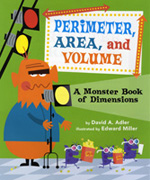 A cast of monsters set out of their 3-D movie to invite the little monsters in the audience on an explanation of the movie set and several math concepts along the way. The monster characters measure each other demonstrating their height and weight. They measure the movie screen and talk about perimeter. They even measure the volume in the popcorn box. A detailed teaching guide/lesson plan is available at the publisher’s website. Read more about this prolific author on his website.
A cast of monsters set out of their 3-D movie to invite the little monsters in the audience on an explanation of the movie set and several math concepts along the way. The monster characters measure each other demonstrating their height and weight. They measure the movie screen and talk about perimeter. They even measure the volume in the popcorn box. A detailed teaching guide/lesson plan is available at the publisher’s website. Read more about this prolific author on his website.
- Karen Hildebrand, Ohio Library and Reading Consultant
Beaumont, Holly. (2012). Multiplication made fun. New York: DK Publishing.
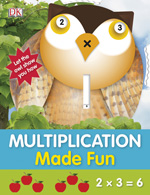 When children need to learn their times tables this beginner’s guide with a wise owl calculator will help make multiplication fun. The book begins with a basic review of what numbers are and discusses the importance of counting. Then it moves into the difference between addition and multiplication, showing how we can count larger amounts by multiplying. Next, the book explains each number two through twelve on individual pages sharing the different multiplication problems. If children get stuck with a multiplication problem they can spin the wheels till the numbers appear in the owl’s eyes and the answer shows in the beak. Throughout the book are tips for grown-ups with suggestions about helping children. This would make a great addition for teachers and families.
When children need to learn their times tables this beginner’s guide with a wise owl calculator will help make multiplication fun. The book begins with a basic review of what numbers are and discusses the importance of counting. Then it moves into the difference between addition and multiplication, showing how we can count larger amounts by multiplying. Next, the book explains each number two through twelve on individual pages sharing the different multiplication problems. If children get stuck with a multiplication problem they can spin the wheels till the numbers appear in the owl’s eyes and the answer shows in the beak. Throughout the book are tips for grown-ups with suggestions about helping children. This would make a great addition for teachers and families.
- Deanna Day, Washington State University Vancouver
Kelly, Jamie/ Jim Benton. (2012). School, hasn’t this gone on long enough? New York: Scholastic.
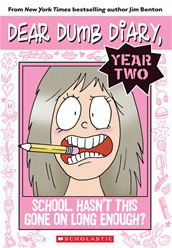 Jamie hates math and writes all about this hatred in her diary. Her best friend, Isabella, is good at math and is willing to help her and in exchange Jamie can help Isabella with language arts. Summer school is threatening on the horizon if Jamie does not bring up those math grades and Isabella’s house is getting a pool! Check out the author’s website for more on The Dumb Diary series including the book trailer for this new Year 2 series.
Jamie hates math and writes all about this hatred in her diary. Her best friend, Isabella, is good at math and is willing to help her and in exchange Jamie can help Isabella with language arts. Summer school is threatening on the horizon if Jamie does not bring up those math grades and Isabella’s house is getting a pool! Check out the author’s website for more on The Dumb Diary series including the book trailer for this new Year 2 series.
- Karen Hildebrand, Ohio Library and Reading Consultant
Mahaney, Ian F. (2012). The math of baseball. New York: Powerkids Press/Rosen Publishing.
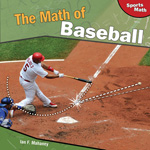 This is part of the series Sports Math from Powerkids Press. Read aloud or individually various aspects of the sport of baseball are explained through the use of mathematics. From the dimensions of a baseball field, to batting averages, hitting distances, strikeouts, scores and statistics the entire sport is covered with figures that deal with addition, subtraction, measurement, percentages and more. Photographs, charts and diagrams add to the appeal of the book and bring a real-life use of math to young readers. Find more math and baseball ideas at The Teachers’ Corner.
This is part of the series Sports Math from Powerkids Press. Read aloud or individually various aspects of the sport of baseball are explained through the use of mathematics. From the dimensions of a baseball field, to batting averages, hitting distances, strikeouts, scores and statistics the entire sport is covered with figures that deal with addition, subtraction, measurement, percentages and more. Photographs, charts and diagrams add to the appeal of the book and bring a real-life use of math to young readers. Find more math and baseball ideas at The Teachers’ Corner.
- Karen Hildebrand, Ohio Library and Reading Consultant
Morrisette, Sharon. (2012). Toads and tessellations: A math adventure. Illus. by Philomena O’Neill. San Franscisco, CA: Charlesbridge Publishing.
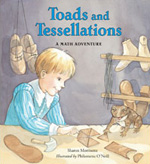 Set in Renaissance Italy, young Enzo is a hoping to become a magician like his father. The cruel castle housekeeper approaches Tessel, the local shoemaker that she needs 12 pairs of dancing shoes for the princesses in the castle and demands the shoes must be made from a single piece of leather. Tessel turns to Enzo for help. His father is away so Enzo must step up to help his friend but his magic goes awry when he turns Tessel into a toad. With Tessel’s daughter Aida for help, they discover a mathematical way to geometrically cut the 12 pair of shoes from one piece of leather. Notes at the end of the book provide some history of mathematics and tessalations. Over twenty tessellations are sprinkled throughout the book for young readers to discover.
Set in Renaissance Italy, young Enzo is a hoping to become a magician like his father. The cruel castle housekeeper approaches Tessel, the local shoemaker that she needs 12 pairs of dancing shoes for the princesses in the castle and demands the shoes must be made from a single piece of leather. Tessel turns to Enzo for help. His father is away so Enzo must step up to help his friend but his magic goes awry when he turns Tessel into a toad. With Tessel’s daughter Aida for help, they discover a mathematical way to geometrically cut the 12 pair of shoes from one piece of leather. Notes at the end of the book provide some history of mathematics and tessalations. Over twenty tessellations are sprinkled throughout the book for young readers to discover.
- Karen Hildebrand, Ohio Library and Reading Consultant
Slade, Suzanne. (2011). Multiply on the fly. Illus. by Erin E. Hunter. Mt. Pleasant, SC: Sylvan Dell Publishing.
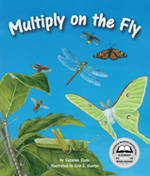 Even in nature numbers are an important part of our world. This picture book combines insects and multiplication together to make learning much more exciting. Each double page spread shares a rhyming multiplication story with a new insect. For example, “Five lonely grasshoppers / sound their mating song. / Each strums two shiny wings. / How many play along?” Then the mathematical equation is shared with a question mark inviting students to figure out the answer. Other insects highlighted include fireflies, luna moths, dragonflies, soldier ants, honey bees, ladybugs, pirate bugs, walking sticks, monarch butterflies and spittlebugs. The back matter includes information about insect body parts, the life cycle of insects, information about comparing and contrasting insects, and a multiplication table.
Even in nature numbers are an important part of our world. This picture book combines insects and multiplication together to make learning much more exciting. Each double page spread shares a rhyming multiplication story with a new insect. For example, “Five lonely grasshoppers / sound their mating song. / Each strums two shiny wings. / How many play along?” Then the mathematical equation is shared with a question mark inviting students to figure out the answer. Other insects highlighted include fireflies, luna moths, dragonflies, soldier ants, honey bees, ladybugs, pirate bugs, walking sticks, monarch butterflies and spittlebugs. The back matter includes information about insect body parts, the life cycle of insects, information about comparing and contrasting insects, and a multiplication table.
- Deanna Day, Washington State University Vancouver
GRADES 9-12
McKellar, Danica. (2012). Girls get curves: Geometry takes shape. New York: Hudson Street Press/Penguin.
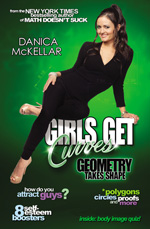 Danica McKellar, actress and mathematician, has written her fourth book for girls. Her earlier books, Math doesn’t suck, Kiss my math, and Hot X: Algebra exposed worked at removing the math “nerd” stereotype for smart girls. Her latest book deals with geometry. NPR interviews author Danica McKellar in addition to the website devoted to this book.
Danica McKellar, actress and mathematician, has written her fourth book for girls. Her earlier books, Math doesn’t suck, Kiss my math, and Hot X: Algebra exposed worked at removing the math “nerd” stereotype for smart girls. Her latest book deals with geometry. NPR interviews author Danica McKellar in addition to the website devoted to this book.
- Karen Hildebrand, Ohio Library and Reading Consultant